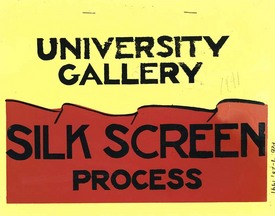Long considered as a commercial method of print production, the silkscreen process received a new appreciation in the mid-1930s, when artist Anthony Velonis, tasked by New York City Mayor Fiorello LaGuardia with a project to promote the city government, embraced the silkscreen method to produce posters that publicized administrative projects in the city. Velonis’s publicity work precipitated the Works Progress Administration (WPA) poster division, and also lead to the establishment of the silkscreen process as a fine art form, termed the “serigraph.” (Read more about Velonis and view posters produced by the WPA Poster Division from the collection of the Library of Congress.)
 In February of 1941, the University Gallery held an exhibition of the silkscreen process and works created by it. An exhibition catalog (at left) was produced by the Gallery using the print method, and includes an overview of the art form, and a step-by-step description of the process. The concluding sentence of this 17 page catalog simply states, “And now we wish you success and much pleasure in working with the silk screen process.”
In February of 1941, the University Gallery held an exhibition of the silkscreen process and works created by it. An exhibition catalog (at left) was produced by the Gallery using the print method, and includes an overview of the art form, and a step-by-step description of the process. The concluding sentence of this 17 page catalog simply states, “And now we wish you success and much pleasure in working with the silk screen process.”
In a clipping from the Star Journal, titled, “Silk Screen prints at ‘U’; Watercolors Shown,” John Sherman indicated in his review of the exhibit that,
One of the solutions of the tough and two-sided problem of getting original art to the art consumer at prices he can afford to pay and at prices which keep the artist solvent, is the silk screen process… The exhibit, rounded out by specimens from eastern artists, will surprise you by the sparkle and variety of its color, and the richness of effects which can be obtained. The medium is highly flexible – few or many colors may be used, and they can be applied “as is” or in combination by means of overprinting and overlapping.
 In another clipping from the Minnesota Daily titled, “Silk Screen Work Shown By Gallery,” (at left) Violet Smith reported that in addition to displaying silkscreen work by artists, the actual frame and squeegee, tools utilized in the production of silkscreen prints, were displayed in the Gallery. The artist Syd Fossum (his work “Gas House District” was part of the exhibit) gave an impromptu demonstration of the process to visitors.
In another clipping from the Minnesota Daily titled, “Silk Screen Work Shown By Gallery,” (at left) Violet Smith reported that in addition to displaying silkscreen work by artists, the actual frame and squeegee, tools utilized in the production of silkscreen prints, were displayed in the Gallery. The artist Syd Fossum (his work “Gas House District” was part of the exhibit) gave an impromptu demonstration of the process to visitors.
University faculty, students, and Gallery employees utilized the silkscreen process to produce exhibition posters and catalogs that promoted the frequently changing exhibitions held in the Gallery. (The work of University student Homer Mitchell is outlined in a previous post.) This work was representative of the curriculum of the Department of Art, part of the College of Science, Literature, and the Arts. A 1951 Course Bulletin (available in the Digital Conservancy’s collection of Course Catalogs, Bulletins and Course Guides) reports the following design courses available to students:
Art 73f-74w-75s. Presentation Techniques. A study of the communication of visual ideas in the fields of exhibition techniques, illustration, and advertising. Source materials available in the nature and tradition and creative use of media are explored as part of the problem of organization.
Art 73f. Experiments in the Use of Wash Techniques, Ink, Gouache, Watercolor, and Other Media. Elementary problems in presentation using the limitations of the media as a starting point…
Art 74w. Discussions and Readings in Area of Visual Communication. Workshop problems in photomechanical and related print processes, air brush, and mixed graphic techniques…
Art75s. Practice in the Use of Symbols in Specific Presentation Problems and a Reconsideration of General Design Principles…